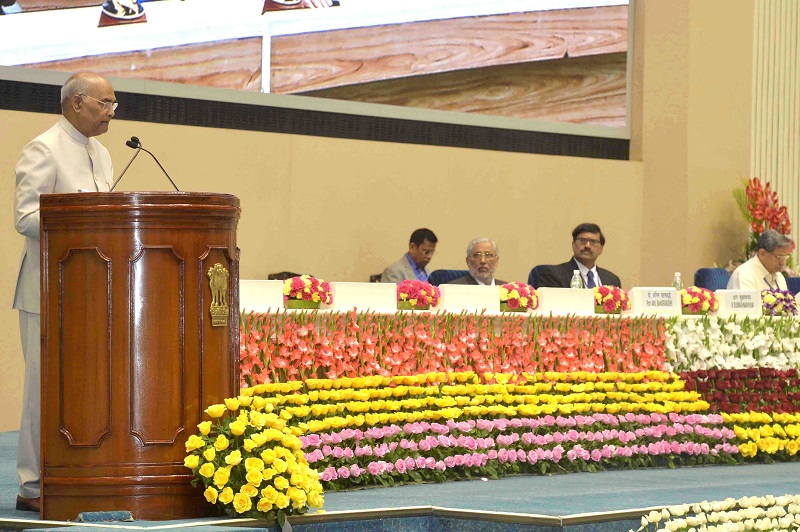ADDRESS BY THE PRESIDENT OF INDIA, SHRI RAM NATH KOVIND ON THE OCCASION OF RELEASE OF INDIA RANKINGS 2019 AND ATAL RANKINGS OF INSTITUTIONS ON INNOVATION ACHIEVEMENT
New Delhi : 08.04.2019

1. I am happy to be here for the release of the India Rankings under the National Institutional Ranking Framework as well as for the Atal Ranking of Institutions on Innovation Achievement. I congratulate the institutions of research and higher education that have topped the rankings and won awards today.
2. I also congratulate officials of the Ministry of Human Resource Development, the National Board of Accreditation and the Information and Library Network Centre for accomplishing the massive task of finalising these rankings. I understand 4,867 applications for rankings in different categories and domains were received from 3,127 institutions. To sift through all these applications – applying qualitative as well as quantitative criteria – must have been an exhausting and yet educative exercise.
3. The higher education system in India is large and complex. Our country has the third biggest such system in the world, with 903 universities, 39,050 affiliated colleges and 10,011 standalone institutions. This network has as many as 34 million students and the strength of the teaching faculty is almost 1.3 million.
4. Higher education is a subject very close to my heart. In my capacity as Visitor of 150 Central Universities and institutions of higher learning, I have had detailed and exhaustive interactions, over five rounds, with vice-chancellors and administrators of such all-India institutions.In the coming period, I plan to have further engagements with students and faculty from these universities.
5. In our country, recent expansion in higher education has widened access and improved equity. Even so, quality remains a concern. While there are islands of excellence, both in the public and private sectors, overall standards are uneven. As India’s higher education infrastructure continues to grow, and as enrolment rises, it is important to lift the bar. A nuanced approach is essential to ensure that higher education not only fulfils individual aspirations, but also achieves national goals and priorities.
6. Quality and excellence are multidimensional. They need to be understood in the context of institutional goals and objectives. The parameters for quality would invariably include quality of infrastructure, faculty, student inputs, curriculum and pedagogy, graduation outcomes, and research. Several of these parameters can be assessed in quantitative terms. However, some of them are highly subjective and therefore difficult to measure and assess. A well-designed ranking system must take both aspects into account.
7. This was a challenge the Department of Higher Education, Ministry of HRD, took up in right earnest in 2015 when it created the National Institutional Ranking Framework. With evolving and expanding parameters, this exercise allows all relevant stakeholders to take stock of the quality and state of higher education institutions in our country. Students and their families can make informed choices. Teachers and the academic community can weigh options. Administrators of institutions can benchmark themselves against their peers and assess scope for improvement. The government can get an idea about gaps and make appropriate policy interventions.
8. I am happy to note that besides overall rankings, category-specific rankings have been undertaken for colleges and universities, as well as subject-specific rankings for engineering, management, pharmacy, architecture, law and medicine. A ranking system of such a nature fosters a spirit of healthy competition between institutions. This is vital because all institutions are today competing for talent – teaching talent, research talent, the most talented students, and even the most enlightened administrators. If an institution wants to attract the best, it too has to be among the best. It has to provide an encouraging atmosphere and suitable campus culture for students and members of the academic community.
9. While some criteria are universal and relevant in universities across the world, I am satisfied to learn that the Indian situation and country-specific parameters have also been considered in devising these rankings. The parameters include regional diversity, outreach, gender equity and access for disadvantaged and traditionally weaker sections.
10. I must point to the relatively low enrolment of girls in our higher education system, particular in the STEM institutions. This is a paradox since girls tend to do very well in school examinations, often outscoring boys. When allowed the opportunity, girl students maintain this trend in higher education as well. Travelling to convocations of universities across the country, I invariably find that female graduates dominate the list of toppers and medallists. And yet many families deny daughters the chance of enrolling for higher education. As a society and as a country, we need to address this.
Ladies and Gentlemen
11. While congratulating institutions that have done well in the India Rankings 2019, I would emphasise to them, and to the others, that this is only a beginning. It is critical that there be a significant Indian presence in global rankings of leading universities and higher educational institutions in the very near future.
12. We live in the age of the Fourth Industrial Revolution, amid a knowledge society and an innovation economy. We cannot realise our potential without the requisite education infrastructure – measured both by numbers and standards. That is why the keen sense with which institutions participate in the India Rankings mechanism should persist and be escalated to striving for and achieving rankings among the global best.
13. Millennia ago, universities such as those of Nalanda made India an international centre of education and knowledge production. In the 21st century, Indian universities must push themselves to reach a similar status. We owe it to our history and our heritage. Much more than that, we owe it to our young people and our future. Go forth, boldly!